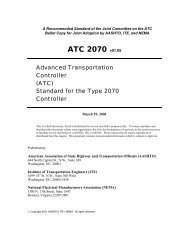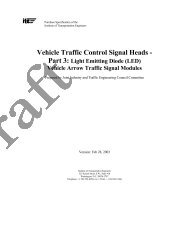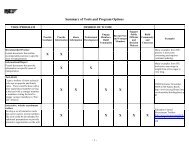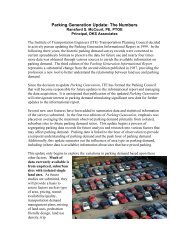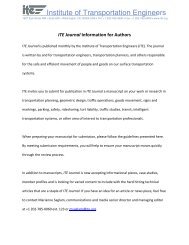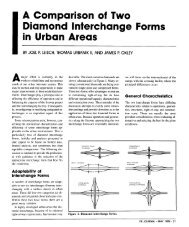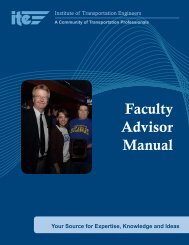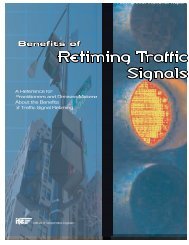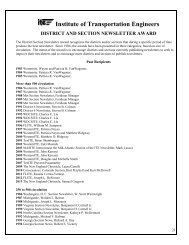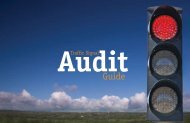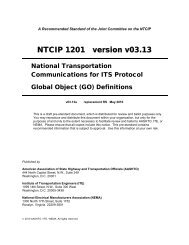Roundabouts vs. Intersections: The Tale of three UAE Cities
Roundabouts vs. Intersections: The Tale of three UAE Cities
Roundabouts vs. Intersections: The Tale of three UAE Cities
Create successful ePaper yourself
Turn your PDF publications into a flip-book with our unique Google optimized e-Paper software.
<strong>Roundabouts</strong> <strong>vs</strong>. <strong>Intersections</strong>: <strong>The</strong> <strong>Tale</strong> <strong>of</strong> Three <strong>UAE</strong><br />
<strong>Cities</strong>.<br />
A review <strong>of</strong> historic developments and current practice with an<br />
aerial photographic documentation<br />
Bassem Younes, Ph.D<br />
<strong>The</strong> United Arab Emirates is one <strong>of</strong> the Gulf cooperation Council member<br />
States in the Middle East. It comprises seven federated Emirates namely Abu Dhabi<br />
(the capital), Dubai, Sharjah, Ajman, Um Al Qaiwain, Ras Al-Khaimah, and Al<br />
Fujairah a . <strong>The</strong> <strong>three</strong> largest urban concentrations are Abu Dhabi, Dubai, and<br />
Sharjah b . Since its independence in December 2 nd 1971, the <strong>UAE</strong> has experienced<br />
phenomenal growth and development fuelled by the production <strong>of</strong> oil and the<br />
prominence <strong>of</strong> some locations as key trading crossroads. <strong>The</strong> <strong>UAE</strong> acts as a service<br />
provider and a major import/re-export center for a catchment area <strong>of</strong> some 1.5 billion<br />
people.<br />
<strong>The</strong> rapid economic growth and fast growing economy resulted in an ever<br />
changing urban scene and setting. Whilst this has been evident in the <strong>three</strong> main<br />
urban centers, the remaining emirates home also experienced major changes, even<br />
if on a lesser scale. <strong>The</strong> transportation system that links the different regions, as well<br />
as the internal or inter-state system is road borne. Traffic has experienced<br />
phenomenal growth on city streets with travel demand and vehicle ownership<br />
experiencing significant increases. Unfortunately, the only records available are form<br />
the city <strong>of</strong> Dubai and to a lesser extent from Abu Dhabi. <strong>The</strong> rate at which the<br />
economy grew has meant that other issues (e.g. Building the necessary<br />
infrastructure to keep up with the increasing demand for movement) took priority<br />
over the systematic monitoring <strong>of</strong> the traffic behavior and the changing transportation<br />
landscape.<br />
Background:<br />
In the early days, the number <strong>of</strong> vehicles was very small. <strong>The</strong> rough and<br />
sandy terrain <strong>of</strong> the area made it only possible for a certain type <strong>of</strong> vehicles to use<br />
the then available tracks. <strong>The</strong> British authorities that then had administrative control<br />
over the whole area had developed the roadway network in accordance with British<br />
engineering standards and codes. It was therefore natural that the roundabout<br />
figured as almost the only type <strong>of</strong> intersection in the roadway network. This was in<br />
line with the acceptable practice where priority central is used to achieve the control<br />
is used to achieve the control <strong>of</strong> traffic movements at intersections where traffic flows<br />
are small.<br />
Examining visual data obtained from an extensive database c has turned out<br />
some fascinating record <strong>of</strong> the history <strong>of</strong> such developments. <strong>The</strong>se are presented<br />
as a main part <strong>of</strong> this paper.
In order to better understand the local situation some thirty years ago and the<br />
present conditions, it is important to highlight some <strong>of</strong> the basic rules and regulations<br />
that govern the planning aspects in the <strong>UAE</strong>.<br />
<strong>The</strong> seven different emirates each have a municipal authority that oversees<br />
the planning, design and implementation <strong>of</strong> transportation facilities. This is usually<br />
carried out through the assistance <strong>of</strong> international consultants who have been<br />
involved in this for many years. <strong>The</strong> different departments within a municipality<br />
undertake the relevant parts <strong>of</strong> the process accordingly. For example, the planning<br />
development would be responsible for the overall structure and strategic planning for<br />
the city. <strong>The</strong> roads department, usually within the same municipality, has its own<br />
road planning section that is responsible for the actual planning <strong>of</strong> roads. <strong>The</strong>reafter<br />
the design and construction sections within the same department handle the plans.<br />
In the early days, land requirements were readily available. As such, even<br />
where the land required for a large island roundabout is greater than that needed for<br />
the traffic signal control (specially where flows on one pair <strong>of</strong> arms are low) the<br />
preference for a roundabout would still be accommodated. <strong>The</strong> fact that most land<br />
was and largely is still owned by the state facilitated such decisions.<br />
At present, the extensive built-up situation evident in the urban centers<br />
mentioned, and the growth in population and vehicle ownership has warranted<br />
considerable changes to the old approach and practice.<br />
<strong>The</strong> conventional roundabouts (the <strong>UAE</strong> has never really implemented miniroundabouts)<br />
have difficulty in dealing with unbalanced flows, especially during peak<br />
hours when the traffic entering on an arm is considerably greater than the traffic<br />
leaving by it. In such situations, there is frequently a shortage <strong>of</strong> gaps in the<br />
circulating stream and as such, delays may become excessive.<br />
As in many other parts <strong>of</strong> the world, roundabouts have been commonly<br />
used in central city areas where traditionally they were used to resolve traffic and<br />
pedestrian conflicts in the large open squares that existed in the early 50’s and 60’s.<br />
<strong>The</strong> central island frequently covered a large area <strong>of</strong> the square and was utilized for<br />
ornamental flowerbeds or statues whilst traffic circulated around the surrounding<br />
carriageway.<br />
Increasing traffic demand, and the pressure to allow pedestrians to cross the<br />
carriageway at grade, has resulted in many <strong>of</strong> these roundabouts being connected to<br />
signal control, so that more positive control over traffic movements on an area wide<br />
basis may be exercised. At first part-time signals were introduced but the continued<br />
growth in demand resulted in most <strong>of</strong> these becoming full-time signals at all the key<br />
locations in the city.<br />
In suburban areas roundabouts are frequently found at the intersection <strong>of</strong><br />
radial type roads where they are subjected to peak hour traffic demands due to<br />
commuter flows. <strong>Roundabouts</strong> were also used on rural roads or inter city links where<br />
traffic flows or the road type did not justify the provision <strong>of</strong> a grade-separated<br />
intersection. In such situations, speeds are usually high on the approaches to<br />
roundabouts and safety is and important consideration.
In addition to the resolution <strong>of</strong> traffic conflicts, roundabouts were employed<br />
where there was a significant change in road type, a change from rural to urban<br />
conditions, or when a significant change in road direction was required. It was<br />
actually believed that roundabouts deal more efficiently than signal control with traffic<br />
movements where there are <strong>three</strong> arms and well-balanced flows (in real life this<br />
cannot be easily arranged). For example, when the number <strong>of</strong> arms exceeds four,<br />
then driver guidance through direction signing becomes difficult. Moreover, with<br />
many approach arms the diameter <strong>of</strong> the roundabout increases, leading to possible<br />
higher circulating speeds and consequent safety problems.<br />
In the prevailing <strong>UAE</strong> practice, there are two basic types <strong>of</strong> roundabouts:<br />
1) Normal or conventional roundabout<br />
One which has a one –way circulatory carriageway around a kerbed central<br />
island 4 m or more in diameter and usually with flared approaches to allow multiple<br />
vehicle entry. <strong>The</strong>re have, however, been a number <strong>of</strong> variations to this definition<br />
evident in many cases and to some extent appearing to be influenced by certain<br />
practice or preference at times. Variations <strong>of</strong> this type include ring junctions; grade<br />
separated roundabouts and signalized roundabouts.<br />
2) Double-roundabouts<br />
A double roundabout is defined as an individual function with two normal or<br />
mini roundabouts either contiguous or connected by a central link road or kkerbed<br />
Island. It is considered that this type <strong>of</strong> function will have advantages in certain<br />
circumstances (e.g. joining two parallel routes separated by a river railway or<br />
motorway, junctions with more than four entries, improving an existing staggered<br />
junction avoiding the need to realign one <strong>of</strong> the approach roads.<br />
Double roundabouts in the form <strong>of</strong> two bridge roundabouts and dumb-bell<br />
roundabouts are utilized in grade-separated intersections. This form <strong>of</strong> roundabout<br />
control is visible along some <strong>of</strong> the Sheikh Zayed road interchanges.<br />
<strong>The</strong> roundabout design has certain limitations. It is usual to add at least one<br />
additional lane at the entry <strong>of</strong> the approach roads to the circulating area with a<br />
maximum addition <strong>of</strong> two lanes, and a maximum entry width <strong>of</strong> four lanes. However,<br />
in cases <strong>of</strong> predicted low future flows, widening may not be considered necessary.<br />
Nevertheless, a minimum <strong>of</strong> two lanes in an entry is desirable. Moreover, the angle<br />
at which vehicles enter the circulating area is <strong>of</strong> considerable importance in the<br />
operation <strong>of</strong> a roundabout as it carries serious safety implications especially in nonsignalized<br />
roundabouts.<br />
Over the years, which experienced a rapid growth in urbanization and,<br />
therefore increased demand for mobility and accessibility, the <strong>UAE</strong> urban centers<br />
have experienced similar problems and challenges. However, the response to these<br />
issues has been anything but similar. <strong>The</strong> product visible today in some centers<br />
appears to be the objective <strong>of</strong> recent developments in centers still lagging behind.
A Brief History <strong>of</strong> Developments<br />
First, there were roundabouts almost everywhere. <strong>The</strong>se were designed and<br />
implemented as per the specific requirements <strong>of</strong> different locations. <strong>The</strong> size d <strong>of</strong><br />
these varied from one junction to another, and at times appeared to be a hasty and<br />
rushed arrangement. In other cases however, especially in the mid 70’s and<br />
thereafter, designs were being based on identified needs and forecasted demands.<br />
<strong>The</strong> Abu Dhabi Experience<br />
Photographic and historical observation and documentation clearly show the<br />
prevailing conditions (at the start <strong>of</strong> the urban explosion witnessed in Abu Dhabi over<br />
the last quarter <strong>of</strong> a century or more) with roundabout dominance on the<br />
infrastructure plan.<br />
<strong>The</strong> city <strong>of</strong> Abu Dhabi appointed Deleuw Cather, a USA engineering<br />
consultancy firm to carry out a planning and transportation study in the early 70’s.<br />
<strong>The</strong> same consultants continued to be involved even to date, with results clearly<br />
influenced by American design standards. It is worth noting that all new junction<br />
control designed in the city has been in the form <strong>of</strong> signalized intersections. This will<br />
be the subject <strong>of</strong> a more detailed research project currently planned within the Civil<br />
Engineering Department at UOS.<br />
<strong>The</strong> following aerial images show these historic developments over time.<br />
<strong>The</strong> Dubai Experience<br />
Dubai, the second and most prominent urban center in the <strong>UAE</strong> has<br />
witnessed rapid and systematic developments <strong>of</strong> the transportation infrastructure.<br />
From a similar situation to that <strong>of</strong> Abu Dhabi during the early period, Dubai<br />
experienced a phenomenal growth in population, vehicle ownership, and the<br />
demands for mobility and accessibility that have resulted in significant changes and<br />
developments over time.<br />
However, Dubai’s approach was somewhat different. Being more <strong>of</strong> a<br />
cosmopolitan center, the local authorities were open to different approaches and<br />
hence varying international design standards and practice. At times, the local needs<br />
and environment had resulted in interesting solutions and sometimes the<br />
combination <strong>of</strong> varying strategies, or techniques in one location. (This too, is the<br />
subject <strong>of</strong> planned research at UOS.)<br />
<strong>The</strong> Dubai roundabouts have been more resistant to change than those <strong>of</strong><br />
Abu Dhabi. This meant that all measures leading to improving roundabout capacities<br />
would be utilized and even exhausted before converting to the other type. Smaller<br />
roundabouts would grow larger at times by means <strong>of</strong> added circulating lanes in this<br />
case. (Wherever land availability permitted), additional lanes added wherever<br />
possible, or at least flared approaches widened etc.
<strong>The</strong>n there were signalized roundabouts. Some were signalized only part<br />
time, others especially those within the central area had full-time signalization. Later,<br />
the increasing demand and the unsuitability <strong>of</strong> the roundabout design to handle<br />
uneven flow balances, warranted the conversion <strong>of</strong> key locations to signalized<br />
intersection operation. This, however, was only carried out after exhausting all signal<br />
timing improvement possibilities.<br />
<strong>The</strong> Sharjah Experience<br />
Sharjah, the cultural center <strong>of</strong> the <strong>UAE</strong> accommodates most <strong>of</strong> the higher<br />
educational and cultural institutions. Its proximity to Dubai has resulted in a lot <strong>of</strong><br />
activity between the two cities.<br />
Starting from similar background to that <strong>of</strong> Abu Dhabi and Dubai, Sharjah<br />
adopted a roundabout orientated city road network. <strong>The</strong> roundabout impleentation<br />
contiued in all new zones and was introduced with new roadway extensions.<strong>The</strong><br />
increased demand for urbanisation and the growth in certain zones, especially within<br />
the industrial area, warranted the signalization <strong>of</strong> key locations. In a fashion similar<br />
to that used in Dubai, part-time signalization went together with full-time signalization<br />
<strong>of</strong> certain locations.This was not a sufficient measure at certain sites. However, only<br />
a couple <strong>of</strong> locations have been converted so far.<br />
Sharjah, has a number <strong>of</strong> what could probably be called the world’s largest<br />
roundabouts. In fact, the term ‘round’ is not appropriate. <strong>The</strong> following images<br />
illustrate this situation. Ongoing research at UOS is investigating the history <strong>of</strong> such<br />
developments and the circumstances which lead to this particular phenomenon.<br />
Summary and Conclusions<br />
Over the last 30 years the overall transportation picture in the <strong>UAE</strong> has been<br />
shaped by a number <strong>of</strong> factors.<br />
- Inherited conditions which were the result <strong>of</strong> certain design practices influenced by<br />
the political situation.<br />
- <strong>The</strong> explosion in urbanization experienced by the <strong>UAE</strong>’s <strong>three</strong> major urban centers,<br />
and the accompanying growth in population and vehicle-ownership warranted<br />
increased capacities and improved traffic control means<br />
- <strong>The</strong> phasing out <strong>of</strong> roundabouts was carried out by Abu Dhabi where American<br />
Consultants and American design practice was involved<br />
- A slower phasing-out process was evident in Dubai and an even slower one<br />
Sharjah<br />
- <strong>The</strong> trend is for a conversion <strong>of</strong> roundabouts to signalized intersection<br />
Signalized intersections cope better with increased traffic demands and provide a<br />
better from <strong>of</strong> traffic control in urban areas where traffic flows are high<br />
- <strong>Roundabouts</strong> have gone through a number <strong>of</strong> modifications and adjustments which<br />
at times appear to challenge the basic idea and purpose <strong>of</strong> a roundabout.
About the Author<br />
Dr. Bassem Younes is an Associate Pr<strong>of</strong>essor <strong>of</strong> Civil Engineering at the<br />
University <strong>of</strong> Sharjah. He holds a PhD and a DIC in Transportation Planning and<br />
Traffic Engineering form the Imperial College <strong>of</strong> London where he completed his<br />
research in 1991.<br />
He has a BSCE and an MSCE in Civil Engineering from Bradley University in<br />
Illinois following which he had academic spills at Purdue and the Georgia Institute <strong>of</strong><br />
Technology in the USA before joining Imperial College.<br />
Dr. Younes has authored a number <strong>of</strong> refereed papers, commissioned<br />
research and organised and participated in several international conferences and<br />
symposiums. His current interests are in Intelligent Transportation Systems (ITS);<br />
Traffic Access and Impact Assessments and the wider strategic planning issues.<br />
He is member <strong>of</strong> several International pr<strong>of</strong>essional organizations and honor<br />
societies.<br />
a <strong>UAE</strong> Basic Information by Emirate
Emirate Area (Square Km) % <strong>of</strong> total population (1998) *<br />
Abu Dhabi 67,340 86.67<br />
Dubai 3,885 5.0<br />
Sharjah 2,590 3.33<br />
Ras Al-Khaimah 1,688.5 2.17<br />
Fujairah 1165.5 1.5<br />
Umm Al-Qaiwain 777 1<br />
Ajman 259 .33<br />
• Estimated<br />
Source: <strong>The</strong> Evolution <strong>of</strong> Planning and Development in the <strong>UAE</strong>: Stages <strong>of</strong> Urban Growth in <strong>UAE</strong> <strong>Cities</strong>.<br />
Directorate <strong>of</strong> Town Planning & Survey, 1999.<br />
Ã<br />
b <strong>The</strong> gradual growth <strong>of</strong> population started in 1963, when the total population reached 95,000. <strong>The</strong> figure<br />
increased to 320,000 in 1972 indicating a four-fold increase within 8 years only.<br />
In 1975, the country’s population was 557,887 rising to 1,042,099 in 1980. <strong>The</strong> 1995 census showed a total<br />
population <strong>of</strong> 2.4 million. 1999 figures indicate a total population <strong>of</strong> 25 million.<br />
<strong>The</strong> Abu Dhabi population increased from 100,000 in 1970 to 150,000 in 1975 and to 243,257 in 1980. 1998<br />
estimates put the figure at 1,050,000 inhabitants.<br />
Dubai’s population was 370,800 in 1985. <strong>The</strong> 1995 census showed a figure <strong>of</strong> 674,100. In other words, the<br />
population more than doubled in ten years. 1998 estimates put the figure at 783,000.<br />
Sarah’s population was a mere 30,000 in 1968. In 1998, the estimates indicate a figure <strong>of</strong> 460,000 <strong>of</strong> which<br />
some 350,000 live in the city <strong>of</strong> Sharjah.Ã<br />
c Source: Maps (<strong>UAE</strong>), a Geosystems company based in Sharjah since the early seventies.<br />
Ã<br />
d <strong>The</strong> size <strong>of</strong> a roundabout is determined by the diameter <strong>of</strong> the inscribed circle. <strong>The</strong> inscribed circle is that<br />
which approximately touches the outer edges <strong>of</strong> the circulating area.<br />
Ã



